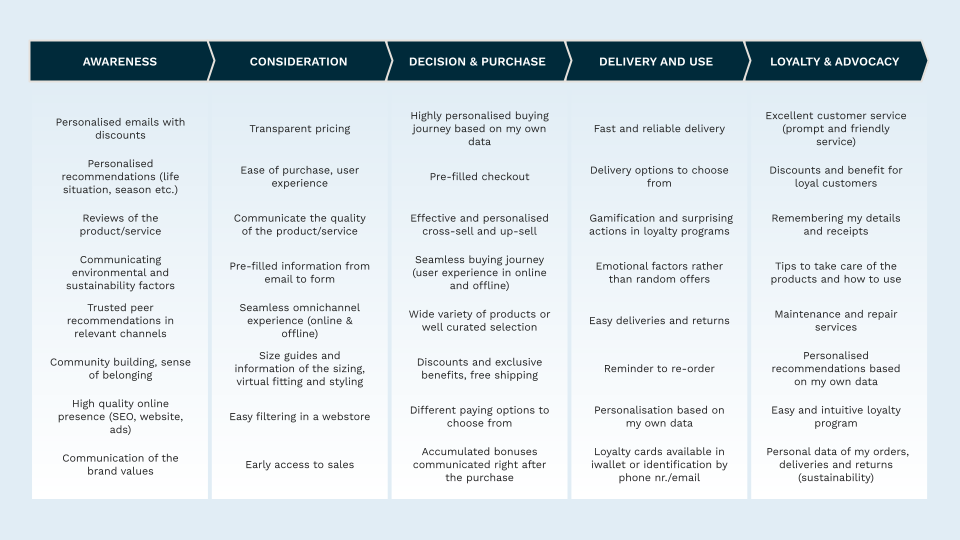The Data Handbook
How to use data to improve your customer journey and get better business outcomes in digital sales. Interviews, use cases, and deep-dives.
Get the bookRecently, we asked 150 Roadies what loyalty means to them in the context of digital commerce. In this article, we share the most interesting insights the digital commerce forerunners have to say about loyalty.
Based on a significant number of loyalty-related projects and personal experiences, the answer is clear: loyalty is much more than just traditional loyalty programs and gathering bonus points.
In 2022, an average consumer was part of 16.6 loyalty programs (Gartner, 2023). This is easy to believe as a Finn who has 10 loyalty cards in my wallet, more than 10 apps on my phone, roughly 30 online memberships attached to my email, and a collection of stamp cards, on top of all the programs I don’t remember being registered to, but get asked each time I visit a brick-and-mortar store or place an online order.
According to Accenture’s survey, more than 90% of companies employ some form of customer engagement or loyalty program. Gartner predicts the market will be much more crowded and the competition will grow in the coming years, as 1 in 3 companies without a loyalty program will launch one by 2027. Evidently, loyalty continues to be one of the top trends of the century, and companies continue to invest in it; either by building new capabilities or revamping and re-platforming existing loyalty programs (Antavo, 2023).
Why loyalty beyond loyalty programs?
We believe that customer loyalty is built over time and is a result of many touch points and activities across the channels and throughout the customer journey.
Loyalty programs have no doubt a central role in the mix, but if loyalty is narrowed down only to “traditional” programs, we believe companies are missing many opportunities. We asked 150 digital sales experts (designers, developers, martechies and sales) to share their personal experiences of loyalty.
According to our survey, digital customer experience is the greatest driver for customer loyalty and trust. After that comes customer service experience, communicating the quality and features of the product or service, and personalisation.
Perhaps surprisingly, other factors, including loyalty programs, are considered to be much less important in creating a feeling of loyalty and trust.

To better grasp what loyalty means beyond traditional loyalty programs, we asked the respondents what loyalty means to them in the context of digital commerce. In this question, we left out the option for “traditional” loyalty programs to give a broader perspective.
81% consider loyalty to be first and foremost personalisation, 65% think it is about customer experience across channels, and 55% consider it a smooth and exceptional customer experience.
Other factors that build customer loyalty are community building and emotional connection (42%) and more traditional characteristics that build a sense of loyalty: brand values (36%), excellent features or capabilities of a product or service (36%), and brand characteristics (26%).

Activities that drive loyalty
Customer experience
Customer experience can mean, for example, relevant recommendations, an excellent omnichannel experience, ease of buying, quick deliveries, easy returns, and excellent customer service. These can happen throughout the customer journey, from awareness to consideration and buying to loyalty and advocacy.
“I would expect a highly personalised buying experience. Current grocery online shopping is quite good but the overall customer journey is not considered with the same depth. Being digitally smooth is not enough, the whole journey needs to be smooth."
Survey respondent
Personalisation
Personalisation and loyalty are closely connected, and properly utilised personalisation can create a lot of value not only for the customer but also for the company. After all, the goal of personalisation is to create engaging experiences, which will ultimately lead to increased loyalty.
Forbes states that loyalty programs also act as a solution for customer data capture in the era of zero-party data. Moreover, a more customised and personalised experience is becoming a default, especially if a company already gathers and owns a lot of customer data.
“I am willing to give personal data only in exchange for better customer experience - if a company collects customer data, I'm expecting to get something in return.”
Survey respondent
Customer service
It is also worth highlighting the importance of customer service as the value of customer service experience is often underestimated. Customer expectations are higher than ever, and instead of having their problem solved, customers want to feel heard and understood. The brands that can deliver this will be rewarded with loyalty.
“Customer service works with no problems. This always "wins me over" if I get flawless customer service.”
Survey Respondent
According to Salesforce, 72% of consumers will stay loyal to companies that provide faster service, and 65% say they will stay loyal if the company offers a more personalised experience.
“For all digital services to persistently remember me, as well as customer service.”
Survey Respondent
How to advance loyalty throughout the customer journey?
Customer loyalty is vital for business success, but it's often hindered by various pain points. One common frustration is physical loyalty cards, which are prone to getting lost. Transitioning to easy and simple digital solutions, such as apps or identification using simply email or a phone number, can provide a more convenient and modern loyalty experience. Simplicity over complexity is valued in our research as well.
"I'm part of multiple loyalty programs, and carrying any kind of card feels outdated. Identification through mobile numbers or apps feels easier nowadays."
Survey respondent
Customers also seek easy access to their purchase history and rewards, highlighting the need for user-friendly interfaces and mobile apps that empower customers to manage their accounts independently.
Aligning rewards and content with customer preferences and personal data is crucial to ensuring that loyalty programs offer meaningful benefits and are considered valuable. An unclear value proposition can create feelings of frustration.
"Loyalty programs (in case I don't clearly feel the value) add an extra layer of stress for me: the card, the loyalty number, whether I am a member or not, and what I lose if I don't have the card with me when at the cashier."
Survey Respondent
Inconsistencies across online and offline channels, as well as overwhelming email marketing, can also lead to customer disengagement. To enhance user experience, brands should focus on delivering personalised and relevant communications while simplifying loyalty program structures.
Consumers expect that the same practicalities apply both online and offline and are tied into a seamless customer experience.
“I wish there were the same practicalities when it comes to customer experience, like utilising points and offers in the same way during the checkout process in online and a brick-and-mortar store. At the cashier, the salesperson asks if I would like to use my loyalty balance, but when I shop online, it is never asked.”
Survey Respondent
Clear and transparent communication about product availability, delivery schedules, and account management processes is essential for building trust and loyalty. Leveraging data analytics and customer data to personalise offerings and experiences is more an expectation of today.
"Providing value for my customer data: personalisation, insightful content, and relevant recommendations."
Survey Respondent
Concluding thoughts on improving customer loyalty
As digital commerce evolves, so does the concept of loyalty. It's no longer only about accumulating points or collecting physical cards; it's about personalisation, exceptional customer experiences, and building emotional connections across the customer journey.
To advance customer loyalty, businesses must embrace digital solutions, simplify loyalty programs, and deliver consistent experiences across online and offline channels. Simplicity and seamless customer experience win over complexity and unclear value propositions.
Based on the insights from the survey, we mapped the most typical activities our digital sales forerunners listed on a customer journey map.

Do you consider these activities something that has been up and running for quite some time already in your company, or is there something you can use as a source of inspiration to improve customer loyalty?
The Data Handbook
How to use data to improve your customer journey and get better business outcomes in digital sales. Interviews, use cases, and deep-dives.
Get the book



